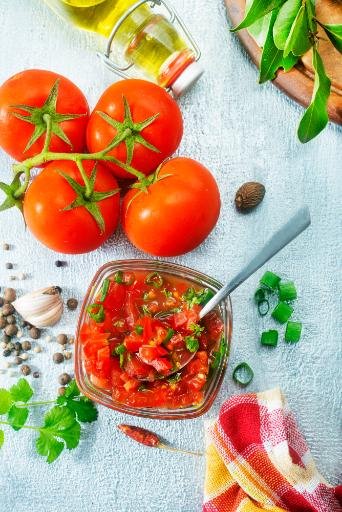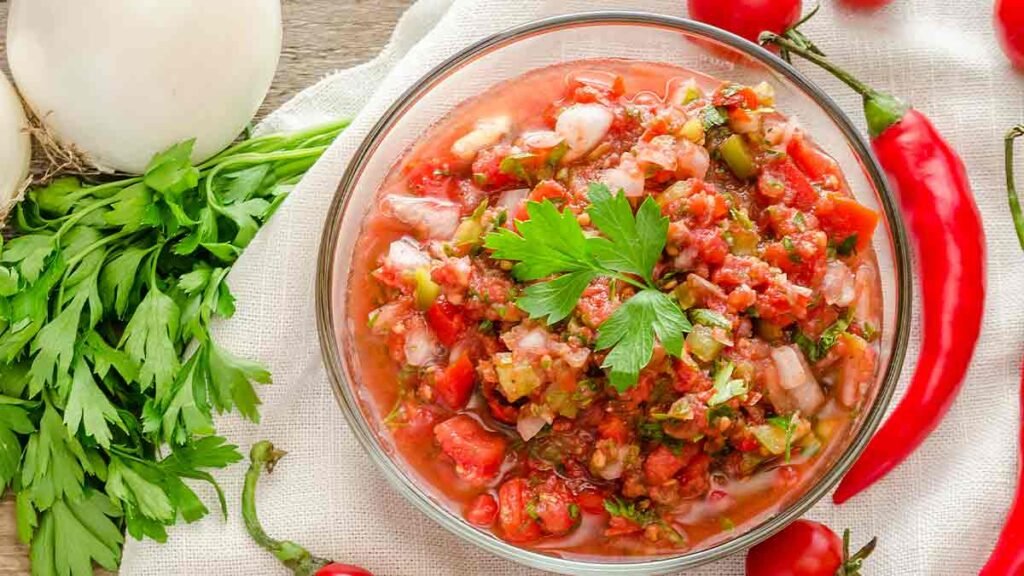Picture a hot Italian summer night where you smell fragrant, ripe tomatoes, basil, and garlic in the air. This is the magic of Italian salsa. It brings Italy’s heart and flavors to your table. Use it to liven up bruschetta, pasta, or enjoy it with fresh bread. Its charm is in the use of fresh, flavorful ingredients and the traditional cooking methods.
Ready to make your own Italian salsa? This recipe will not only tease your taste buds but also infuse your meals with Italian flair. Cutting and mixing these ingredients means you’re part of a rich food tradition. A tradition that highlights Italy’s love for fresh ingredients and bold flavors. So, let’s get started on making a salsa that’s not just tasty but also versatile.
Introduction to Italian Salsa
Italian salsa, called “salsa italiana,” is key in Italian cooking. It’s made from fresh stuff to make dishes taste great. This salsa shows Italy’s love for simple, top-notch ingredients.
To make real Italian salsa, focus on the details and love the taste. A typical recipe uses tomatoes, garlic, onions, and lots of basil and parsley. The mix of these basics lets their flavors stand out in a wonderful way.
A true Italian salsa is all about being fresh and real. Using the best ingredients makes every bite amazing. It’s a great dish for anyone, whether you’re a pro chef or just starting out.
Learning about Italian salsa adds to its value. It’s not just food; it’s part of an Italian lifestyle that cherishes meals together. Making this salsa is more than cooking; it’s about connecting with Italy’s culture.
Ingredients Needed for Your Italian Salsa
The key to an amazing italian salsa is to use fresh, high-quality ingredients. This ensures your homemade italian salsa is full of flavor. It will make your taste buds very happy.
Main Ingredients
The main ingredients are crucial for a great Italian salsa. They are the heart of the recipe, providing key flavors and textures:
- Fresh, ripe tomatoes: Choose tomatoes that are vine-ripened for the best flavor. You want them to be juicy.
- Fresh basil: Basil is key in Italian food. It offers a fragrant and slightly peppery taste.
- Quality olive oil: Top-notch olive oil makes the salsa rich and smooth.
- Garlic: Use finely minced garlic for a sharp, sweet contrast when mixed with tomatoes.
- Red onion: It brings a bit of crunch and a zesty kick to the salsa.
- Salt: Use sea salt or kosher salt to season and enhance the natural flavors.
- Pepper: Freshly ground black pepper adds spiciness and depth.
Optional Additions
You can make your Italian salsa unique with optional add-ins. These ingredients add more flavor and complexity to your salsa:
- Red pepper flakes: Great for those who like a little heat.
- Parsley: Chopped parsley gives a fresh and bright taste.
- Lemon zest: Lemon zest adds a zing and makes the salsa fresher.
- Capers: They add a tangy taste that works well with the tomatoes.
- Balsamic vinegar: Balsamic vinegar adds a sweet and tangy balance to the salsa.

Step-by-Step Italian Salsa Recipe
To make the perfect fresh Italian salsa, start by getting your ingredients ready. Once all is set, make your cooking area ready for action. Here’s how to make a great homemade Italian salsa step by step:
Step 1: First, grab some fresh, ripe tomatoes. Cut them into small, even pieces. It’s also key to take out the seeds for a smoother salsa.
Step 2: Next, finely chop a medium-sized onion. The smaller you chop it, the more it blends into the salsa. Toss it in with the tomatoes.
Step 3: Now mince the garlic cloves. It’s up to you how much garlic to use. For a strong taste, go with 2-3 cloves. Mix them with the rest.
Step 4: Want some spice? Dice up fresh chili peppers. For less heat, get rid of the seeds and insides. Add them to your salsa.
Step 5: Time to chop some fresh herbs. Basil is classic but parsley or oregano work too. Blend them well with the tomatoes.
Step 6: Now, a little extra-virgin olive oil. It makes the salsa smooth and brings out flavors. Mix everything together.
Step 7: Squeeze fresh lemon juice into the salsa. The lemon makes it fresher and balances the taste.
Step 8: Don’t forget to add salt and pepper. Start with a pinch and add more if needed as you taste.
Step 9: Let your homemade Italian salsa rest for 30 minutes. Time helps the flavors come together, making the salsa really tasty.
Follow these steps for a tasty, bright, fresh Italian salsa. It’s great for any meal. Enjoy this salsa with your favorite foods and taste Italy with every spoonful.
Tips for Making the Best Italian Salsa
Making fresh italian salsa needs the right ingredients and a good balance of flavors. These tips will make your salsa unforgettable.
Choosing the Best Tomatoes
Choose tomatoes well for a tasty salsa. Vine-ripened tomatoes bring out the best flavors. Plum or San Marzano tomatoes work well because they are sweet with few seeds. Make sure the tomatoes are ripe for the best taste and texture.
Balancing Flavors
Getting the flavors right can make your salsa great. Adjust the acidity with lemon juice or vinegar. Add a bit of sugar or honey for sweetness. Then, tune the herb flavors, like basil and parsley, to blend everything perfectly.
Serving Suggestions for Homemade Italian Salsa
Homemade salsa brings a burst of flavor to your table. It perks up any meal with its lively taste. Here are some great ways to enjoy your authentic Italian salsa.
Pairing with Dishes
This salsa isn’t just for dipping chips. It tastes amazing on top of bruschetta. Toast some bread, add salsa, and you have a quick, tasty snack.
For dinner, mix the salsa into pasta for a fresh flavor. It works wonders on spaghetti or with stuffed ravioli. You could also use it as a sauce on grilled chicken or prawns for a flavor boost.
It’s also perfect for vegetarians. Top grilled veggies or a chickpea salad with it. The salsa makes vegetarian dishes just as exciting as their meaty friends.
Presentation Tips
How you serve your salsa matters. Bright salsa looks great in clear or white bowls. It’s all about making the colors pop.
Add a few basil leaves or some Parmesan on top. This not only tastes good but also looks nice. A little olive oil on top gives it a professional, Mediterranean touch.
With these tips, you’ll turn a simple salsa into a stand-out dish. Make every meal memorable with your homemade Italian salsa.
Health Benefits of Fresh Italian Salsa
Including fresh Italian salsa in your meals offers many health perks. It’s full of nutrients from tomatoes, bell peppers, onions, and herbs. Tomatoes are a great source of vitamin C and vitamin A, key for a strong immune system and eyesight.
The salsa’s herbs bring antioxidants that fight oxidative stress. This lowers inflammation. Basil and oregano also have essential oils. These oils are anti-inflammatory and fight off bacteria, helping your health.
Fresh Italian salsa is low in calories, unlike high-fat or sugary sauces. It adds taste without adding to your waistline. It’s also free from processed ingredients, making it a healthy choice for your meals.
The salsa’s veggies are high in fiber, which is good for your gut. Choosing fresh ingredients keeps your salsa free of harmful chemicals. This makes your diet more natural and nutritious.
The perks of Italian salsa go beyond its great taste. It’s a fresh, nutritious add-on that fits well with a healthy diet. It’s a great option for anyone wanting to improve their food and health together.
How to Store and Preserve Your Italian Salsa
Proper storage keeps your Italian salsa fresh and tasty. Whether eating it soon or later, here’s how to store it well.
Short-term Storage
Refrigerate your salsa for a week in a sealed container. A clean spoon keeps it fresh because it avoids adding bacteria. Try using smaller containers to limit air contact when you open it.
Long-term Preservation
Freezing your salsa lets you enjoy it for up to six months. Use bags or containers made for the freezer. Always leave room for it to expand.
Canning is great for keeping your salsa fresh a year. First, make sure your jars and lids are sterile. After filling them with hot salsa, process in a water bath for 15-20 minutes. Let them cool, and check the seals before you use them.
With these tips, your homemade Italian salsa can last for a long time. Enjoy your salsa’s amazing taste for weeks, months, and even a year.
Conclusion
We’ve gone deep into making an incredible Italian salsa recipe. The key is using the best fresh ingredients and preparing them carefully. From ripe tomatoes to the right herbs and seasonings, each part is essential. Making it, whether for a quick bite or something fancy, will add a lot of flavor to your dish.
Italian salsa fits with many dishes, like on grilled fish or with breadsticks for dipping. It also works well in pasta salads, adding a Mediterranean touch. You can tweak the recipe to your liking, trying new things to see what you like best. This freedom is what makes cooking at home great.
And there’s the bonus of being able to store your salsa. Quick storage keeps it fresh for right away, and storing it long-term means you always have some on hand. With this guide, making great Italian salsa regularly is within your grasp. Enjoy the fun of cooking and the great taste of your homemade salsa.
FAQ
What makes Italian salsa different from other salsas?
Italian salsa uses fresh, top-notch ingredients. This includes ripe tomatoes, fresh basil, and extra virgin olive oil. It sticks to traditional Italian recipes which are all about simplicity and real taste. This brings out the salsa’s rich and natural flavors.
Can I make Italian salsa at home?
Yes, homemade Italian salsa is easy with a handful of fresh items. Just follow an authentic Italian salsa recipe. You’ll soon have a tasty condiment that goes well with many dishes.
What are the essential ingredients for making Italian salsa?
You’ll need fresh ripe tomatoes, basil, garlic, and good olive oil for Italian salsa. You can also add oregano, spices, or other flavors to make it your own.
How do I ensure my Italian salsa has balanced flavors?
To get the flavors right, tweak the acidity and sweetness. You can use lemon juice, vinegar, or sugar for this. Don’t forget fresh herbs and the perfect amount of salt for balance.
How should I serve homemade Italian salsa?
Serve Italian salsa on bruschetta, pasta, or as a side for meats or veggies. Sprinkle it with basil or a bit of olive oil for a nice touch.
What are the health benefits of eating fresh Italian salsa?
Eating fresh Italian salsa means getting vitamins, minerals, and antioxidants. It’s low in calories and boosts your health. So, it’s a great addition to any diet.
How should I store homemade Italian salsa?
Keep your Italian salsa fresh by putting it in the fridge for a few days. For longer storage, you can can or freeze it. This keeps the salsa tasty over time.
Can I customize my Italian salsa recipe?
Yes, you can put your own spin on Italian salsa. Add different herbs, spices, or flavors. This way, you can make the perfect salsa for you.


1 Comment
I am really inspired together with your writing abilities and also with the layout for your
weblog. Is that this a paid subject matter or did you customize it yourself?
Anyway stay up the excellent quality writing, it’s rare to see a nice weblog
like this one today. Fiverr Affiliate!